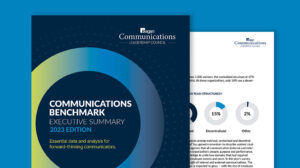How to streamline and strengthen your return-to-work plan
Address vaccine concerns with compassion, clarity and empathy, and remain flexible. Above all, listen to what your employees are telling you.

Now that all U.S. adults are eligible for COVID-19 vaccination and herd immunity seems within reach, it’s tempting to imagine getting back to normal.
In fact, more than half of all American adults are at least partially vaccinated and therefore able to start socializing with other fully vaccinated people, according to CDC guidelines. But the reality is that we still have a long way to go and a lot of work to do to define what “normal” looks like, especially when it comes to re-entering the workplace.
Employers are faced with a massive conundrum. Most agree that it will be difficult to both mandate and track employee vaccinations, and many have concerns about how their people might respond to such a mandate. At the same time, according to a recent survey completed in partnership with KRC Research, nearly four in 10 employees will not feel safe returning to their place of work without the required vaccination of their peers.
To ensure the continued safety of the workforce, every employer will need to have a plan for how they’re going to handle vaccination issues — not just when it comes to workplace safety but how to accelerate getting their workforce vaccinated and back to work. Here are top considerations and recommendations as your business navigates a path forward.
Consider the perspectives of your people through deep listening.
While many leaders have strong preferences for getting people back into workplaces, the majority of employees do not feel the same way.
After a year of alternative work arrangements, our research shows that 85% of employees currently working from home are satisfied with their job. Of those, 82% say that they would like to continue working from home rather than going to their place of work every day.
More than half of the people we surveyed would go further to request to continue working from home if vaccines aren’t mandated by their employer, with 4% considering leaving their job if they are forced to go back without a company policy that requires vaccination.
Therefore, actively listen to your people, and ensure you are hearing from different populations via surveys, “ask me anything” sessions and through direct outreach.
Understand the key drivers of vaccine hesitancy to address them in an inclusive way.
On the other end of the spectrum, there are many reasons why people are hesitant to get the vaccine. Understanding these reasons and how they vary among audiences is important for addressing them.
For example, many people question the safety and efficacy of the vaccines and are concerned about potential side effects. Some are responding to mixed messages from government leaders. And the history of exploitation and neglect that people of color and other minorities have experienced at the hands of the medical establishment cannot be ignored. By understanding the intersection of health and racial equity, you can ensure DE&I is embedded into employee vaccine communications.
Seek to meet people where they are, with the information they need.
Except for hardcore “nevers” (approximately 15% of the adult population), most skeptical or hesitant people are open to changing their mind. Accurate information from trusted sources is key to reaching this group. People seek leadership, science and medical-based opinions.
More people are turning to friends and family when it comes to making their own health decisions, which highlights the importance of accurate, understandable and shareable information as part of grassroots communication efforts.
To reach employees with a clear and accurate message, create an employee engagement campaign to educate about the vaccine and promote vaccination. Equip managers — the No. 1 channel for reaching employees — with the information that they need to best support the campaign.
Explore alternative ways to promote vaccine adoption.
Because of the tensions between those people who would feel more comfortable with a vaccine and those who are more reticent, leaders should focus on incentivizing versus mandating vaccination. While there is a precedent for requiring health screenings across sectors, particularly in those with large populations of frontline workers, requiring employees to get vaccinated (even with the overwhelming evidence about the efficacy of the vaccine) may be seen by some as an overstep of privacy. Or worse.
Some incentives include covering administration or transportation costs, providing time off or additional pay, and including vaccines in health resources already offered through employee assistance and/or or workplace wellness programs.
Evaluate what’s driving the need to return to workplaces.
Pushing people back to work before they are ready, and before other social systems — like the reopening of schools — are in place could have a terrible impact on morale, productivity and even retention. When possible, companies are better off remaining flexible with their workplace policies. If your company is not in a position to offer much flexibility, employers should be clear about the criteria that went into the decision, which should at a minimum include observance of local and national public health guidance.
Continue (or restart) best practices in employee communications.
Over the past year, we have seen an incredible rise in transparency and empathy across companies–and especially in leaders. And as a result, 73% of employees say their employers have communicated effectively with them; of those, 90% are proud to work for their company and 86% believe the company’s response to the pandemic is exactly what it should be.
Comparatively, of those employees who did not receive communications, only 49% are proud to work for their employer, and 37% believe their employer’s response was what it should be. Clearly, effective internal communications pays dividends. And organizations that focus on maintaining and expanding communications and proactively evolving employee experience will see benefits to reputation and performance in the short and long term.
It’s in every company’s best interest not only to encourage vaccinations among their employees but to support broader vaccination efforts and play a role in getting their customers and communities vaccinated. Many brands are already leading the charge, from offering large spaces for vaccination sites to donating advertising space to advocating for equitable vaccine distribution. In addition to being the right thing to do for everyone’s collective safety, there’s a business case as more vaccinated people means fewer business interruptions and, of course, a faster return to normal.
Kate Bullinger is the CEO of United Minds.
Emily Caruso is the SVP of United Minds.
Read more of their work at TLNT.







I work for a small credit union in Seattle and one thing we have been doing is to call it “return to HQ,” not “return to work.” No one has stopped working in the last 18 months.